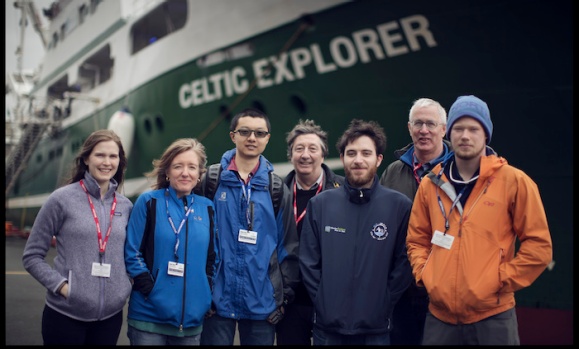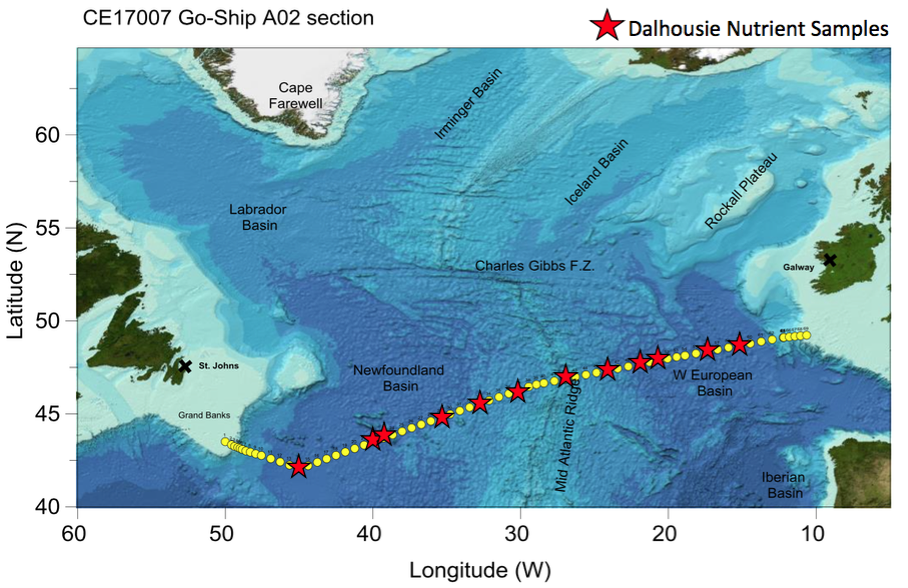News
» Go to news mainAn International Inter‑comparison of Nutrient Analysis at Sea

In 2017, researchers from the CERC.OCEAN team and the Marine Institute in Galway, Ireland, decided that the perfect place to examine the inter-comparability of nutrient data was onboard the R/V Celtic Explorer as it traversed the rough and rolling North Atlantic Ocean. In March of 2019, less than two years later, CERC.OCEAN team members Liz Kerrigan, Claire Normandeau, and Dr. Doug Wallace along with their international colleagues at the Marine Institute published the resuts of this inter-comparison, “A rare intercomparison of nutrient analysis at sea: lessons learned and recommendations to enhance comparability of open-ocean nutrient data”, in Earth System Science Data.
A nutrient inter-comparison itself is not novel idea, but often these inter-comparisons are done within a lab setting, where certified water with a known nutrient concentration is sent to different nutrient analysis groups across the world. Unsurprisingly, it is much easier to run samples in a controlled and stable lab setting, where instruments are set-up and carefully equipped to analyze these samples. Analyzing nutrients at sea is comparatively a lot more difficult and a lot less predictable; protocols have to be changed to accommodate for analysis at sea – water sources may vary, chemicals must be pre-weighed, and instruments must be stabilized to deal with the rolling ship. Any potential mistakes, errors, or broken equipment has to be planned and anticipated ahead of time because there is no ordering new equipment in the middle of the North Atlantic. However, despite all the added planning, stress, and potential variability in the instrument’s performance, when compared to a hyper-controlled lab setting this may result in a much more realistic inter-comparison experiment, shedding light on how inter-comparable nutrient results are when measured at sea.
Our two groups decided that this GO-SHIP cruise (read more about it HERE) across the North Atlantic would be the perfect opportunity to directly compare two “at-sea” nutrient methods. Both the MI (Marine Institute in Galway, Ireland) and Dal (CERC.OCEAN group at Dalhousie University, Halifax, Canada) groups brought laboratory containers onboard, which contained each groups’ respective nutrient analyzers. Both groups used Skalar San++ Continuous Flow Analyzers, with only a few differences in the analytical methods (you can read more about these differences in our paper HERE), however none of these differences impacted the inter-comparability. As the main nutrient analyzer on this cruise, the MI sampled every station and depth, per GO-SHIP requirements, while the Dal group sampled stations intermittently to perform an inter-comparison with the MI’s data. Of the 67 stations occupied during this A02 line transit, 12 were analyzed by both groups and were discussed in the inter-comparison.

Stations sampled across the North Atlantic Ocean during this GO-SHIP cruise. Only the stations identified with red stars were used in the inter-comparison.
In addition to the 12 stations analyzed on both systems and used in the inter-comparison, certified reference materials with defined nutrient concentrations were also analyzed to aid in quality control and establishing the inter-comparability of the system and methods.
In general, there was high comparability between the nutrients analyzed on these two systems; the vertical profiles of nutrients measured at these 12 stations also compared well with nutrient data collected along the same A02 transect by the World Ocean Circulation Experiment (WOCE) in 1997. The largest differences were observed in the surface waters, where the nutrient concentrations were typically the lowest. Through this inter-comparison, the need to use multiple reference materials (ideally a low, medium, and high concentration) to cover the full range of expected nutrient concentrations was highlighted. Using multiple reference materials can identify bias as well as non-linearity in the calibrations, which was only evident by comparing calibration curves and reference materials analyzed by both systems onboard.
Based on this inter-comparison, some interesting questions have been posed and a number of suggestions have been made to enhance existing GO-SHIP guidelines. Some of the key recommendations from this inter-comparison are (1) to clearly define data quality objectives for nutrient measurements at sea as well as (2) establishing a flagging method to report data that do not meet these criteria.
To learn more about this survey and the other CERC.OCEAN research that went on during this trans-Atlantic cruise read more HERE. To learn more about our nutrient inter-comparison, read the full-text research paper we wrote along with researchers from the Marine Institute HERE.
McGrath, T., Cronin, M., Kerrigan, E., Wallace, D., Gregory, C., Normandeau, C., McGovern, E. 2019. A rare intercomparison of nutrient analysis at sea: lessons learned and recommendations to enhance comparability of open-ocean nutrient data. Earth System Science Data. https://doi.org/10.5194/essd-11-355-2019
Recent News
- Recap of ASITA 2024 Conference
- ASITA 2024 Conference
- Happy World Ocean Day! + CMOS congress 2023 recap
- Upcoming presentations by CERC.OCEAN lab at the CMOS 57th congress
- UPDATED: List of Instrumentation and Analytical Services
- Field Report: Exploratory Study of nitrogen cycling at the Lagoon Lagos
- Marine Robots – Back in Action at OHMSETT
- Spotlight of the month: Adriana Reitano

